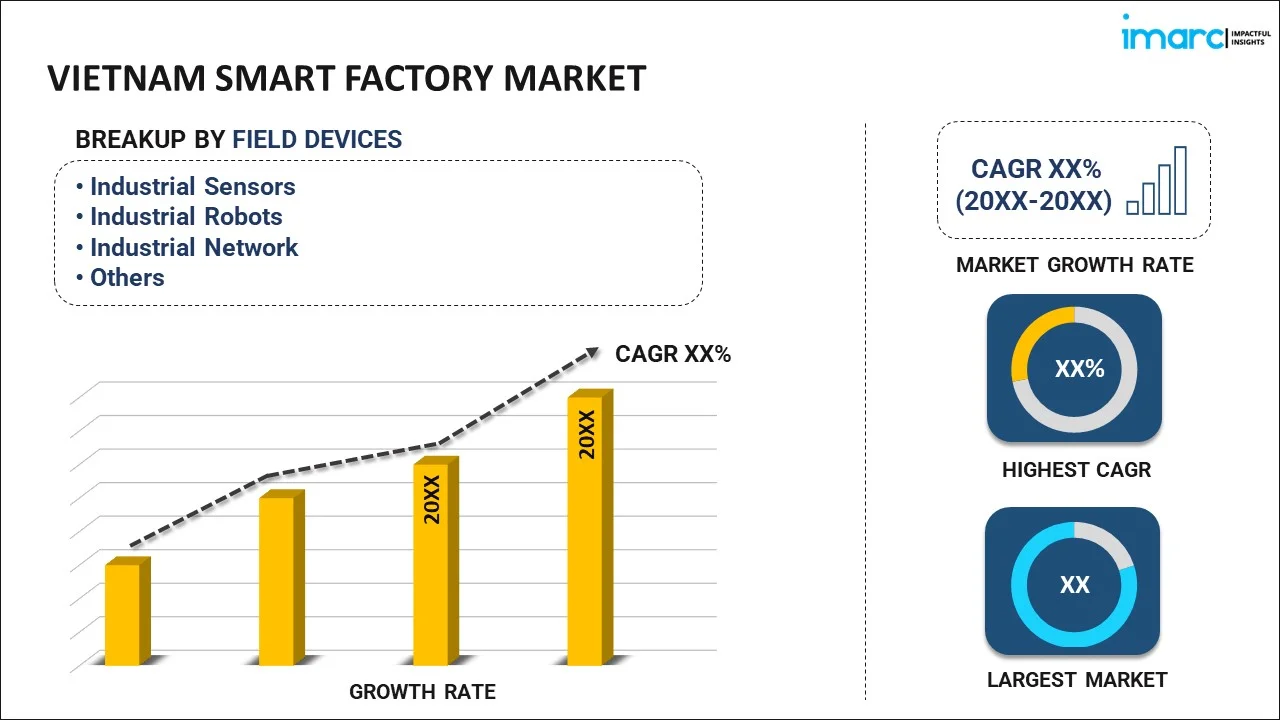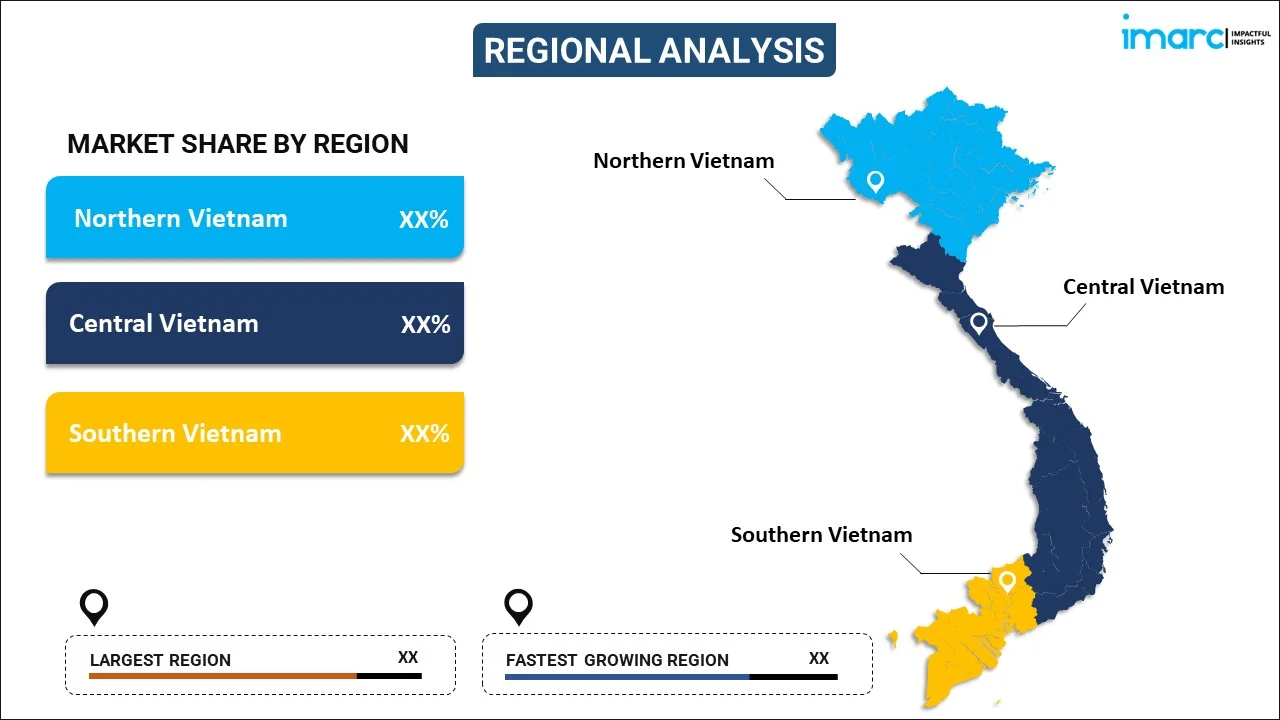
Vietnam Smart Factory Market Report by Field Devices (Industrial Sensors, Industrial Robots, Industrial Network, Industrial 3D Printers, Machine Vision Systems), Technology (Product Lifecycle Management (PLM), Human Machine Interface (HMI), Enterprise Resource Planning (ERP), Manufacturing Execution Systems (MES), Distributed Control Systems (DCS), Industrial Control System, and Others), End Use Industry (Pharmaceuticals, Food and Beverages, Chemical, Oil and Gas, Automotive and Transportation, Semiconductor and Electronics, Aerospace and Defense, and Others), and Region 2025-2033
Market Overview:
Vietnam smart factory market size is projected to exhibit a growth rate (CAGR) of 10.3% during 2025-2033. The elevating adoption of machines and robots that aid in handling repetitive tasks with precision, allowing human workers to focus on more complex activities, is primarily driving the market growth.
|
Report Attribute
|
Key Statistics
|
|---|---|
|
Base Year
|
2024 |
|
Forecast Years
|
2025-2033 |
|
Historical Years
|
2019-2024
|
| Market Growth Rate (2025-2033) | 10.3% |
A smart factory denotes a highly advanced manufacturing facility employing state-of-the-art technologies and automated systems to streamline production processes, boost efficiency, and elevate overall operational effectiveness. This innovative manufacturing environment harnesses cutting-edge technologies such as the Internet of Things (IoT), artificial intelligence (AI), robotics, data analytics, and cloud computing to establish a highly interconnected and intelligent production setting. Within a smart factory, machinery and equipment are equipped with sensors and linked to a central network, enabling real-time data collection and analysis. This facilitates predictive maintenance, early identification of issues, and proactive decision-making to minimize downtime and enhance productivity. Through the integration of data analytics and AI, smart factories optimize production planning, inventory management, and supply chain logistics. They facilitate real-time monitoring of production metrics, quality control, and performance indicators, allowing for swift adjustments and continuous improvement. The advantages of smart factories encompass heightened productivity, reduced costs, improved product quality, enhanced worker safety, and increased flexibility in responding to market demands.
Vietnam Smart Factory Market Trends:
The Vietnam smart factory market is experiencing a transformative surge, reflecting the nation's commitment to technological advancements and efficient industrial practices. Smart factories in Vietnam represent the integration of cutting-edge technologies, such as the Internet of Things (IoT), artificial intelligence (AI), robotics, data analytics, and cloud computing into manufacturing processes. This results in highly interconnected and intelligent production environments that optimize efficiency and operational performance. In these smart factories, machinery and equipment are equipped with sensors, enabling real-time data collection and analysis, which is acting as another significant growth-inducing factor. Besides this, the integration of data analytics and AI in Vietnam's smart factories optimizes production planning, inventory management, and supply chain logistics, enabling real-time monitoring of production metrics and quality control. The benefits are manifold, including increased productivity, reduced costs, improved product quality, heightened worker safety, and enhanced flexibility in responding to market demands. As Vietnam positions itself as a technological hub in Southeast Asia, the regional market is anticipated to fuel the market growth over the forecasted period.
Vietnam Smart Factory Market Segmentation:
IMARC Group provides an analysis of the key trends in each segment of the market, along with forecasts at the country level for 2025-2033. Our report has categorized the market based on field devices, technology, and end use industry.
Field Devices Insights:

- Industrial Sensors
- Industrial Robots
- Industrial Network
- Industrial 3D Printers
- Machine Vision Systems
The report has provided a detailed breakup and analysis of the market based on the field devices. This includes industrial sensors, industrial robots, industrial network, industrial 3d printers, and machine vision systems.
Technology Insights:
- Product Lifecycle Management (PLM)
- Human Machine Interface (HMI)
- Enterprise Resource Planning (ERP)
- Manufacturing Execution Systems (MES)
- Distributed Control Systems (DCS)
- Industrial Control System
- Others
A detailed breakup and analysis of the market based on the technology have also been provided in the report. This includes product lifecycle management (PLM), human machine interface (HMI), enterprise resource planning (ERP), manufacturing execution systems (MES), distributed control systems (DCS), industrial control systems, and others.
End Use Industry Insights:
- Pharmaceuticals
- Food and Beverages
- Chemical
- Oil and Gas
- Automotive and Transportation
- Semiconductor and Electronics
- Aerospace and Defense
- Others
The report has provided a detailed breakup and analysis of the market based on the end use industry. This includes pharmaceuticals, food and beverages, chemical, oil and gas, automotive and transportation, semiconductor and electronics, aerospace and defense, and others.
Regional Insights:

- Northern Vietnam
- Central Vietnam
- Southern Vietnam
The report has also provided a comprehensive analysis of all the major regional markets, which include Northern Vietnam, Central Vietnam, and Southern Vietnam.
Competitive Landscape:
The market research report has also provided a comprehensive analysis of the competitive landscape in the market. Competitive analysis such as market structure, key player positioning, top winning strategies, competitive dashboard, and company evaluation quadrant has been covered in the report. Also, detailed profiles of all major companies have been provided.
Vietnam Smart Factory Market Report Coverage:
| Report Features | Details |
|---|---|
| Base Year of the Analysis | 2024 |
| Historical Period | 2019-2024 |
| Forecast Period | 2025-2033 |
| Units | Billion USD |
| Scope of the Report | Exploration of Historical Trends and Market Outlook, Industry Catalysts and Challenges, Segment-Wise Historical and Future Market Assessment:
|
| Field Devices Covered | Industrial Sensors, Industrial Robots, Industrial Network, Industrial 3D Printers, Machine Vision Systems |
| Technologies Covered | Product Lifecycle Management (PLM), Human Machine Interface (HMI), Enterprise Resource Planning (ERP), Manufacturing Execution Systems (MES), Distributed Control Systems (DCS), Industrial Control System, Others |
| End Use Industries Covered | Pharmaceuticals, Food and Beverages, Chemical, Oil and Gas, Automotive and Transportation, Semiconductor and Electronics, Aerospace and Defense, Others |
| Regions Covered | Northern Vietnam, Central Vietnam, Southern Vietnam |
| Customization Scope | 10% Free Customization |
| Post-Sale Analyst Support | 10-12 Weeks |
| Delivery Format | PDF and Excel through Email (We can also provide the editable version of the report in PPT/Word format on special request) |
Key Questions Answered in This Report:
- How has the Vietnam smart factory market performed so far and how will it perform in the coming years?
- What has been the impact of COVID-19 on the Vietnam smart factory market?
- What is the breakup of the Vietnam smart factory market on the basis of field devices?
- What is the breakup of the Vietnam smart factory market on the basis of technology?
- What is the breakup of the Vietnam smart factory market on the basis of end use industry?
- What are the various stages in the value chain of the Vietnam smart factory market?
- What are the key driving factors and challenges in the Vietnam smart factory?
- What is the structure of the Vietnam smart factory market and who are the key players?
- What is the degree of competition in the Vietnam smart factory market?
Key Benefits for Stakeholders:
- IMARC’s industry report offers a comprehensive quantitative analysis of various market segments, historical and current market trends, market forecasts, and dynamics of the Vietnam smart factory market from 2019-2033.
- The research report provides the latest information on the market drivers, challenges, and opportunities in the Vietnam smart factory market.
- Porter's five forces analysis assist stakeholders in assessing the impact of new entrants, competitive rivalry, supplier power, buyer power, and the threat of substitution. It helps stakeholders to analyze the level of competition within the Vietnam smart factory industry and its attractiveness.
- Competitive landscape allows stakeholders to understand their competitive environment and provides an insight into the current positions of key players in the market.
Need more help?
- Speak to our experienced analysts for insights on the current market scenarios.
- Include additional segments and countries to customize the report as per your requirement.
- Gain an unparalleled competitive advantage in your domain by understanding how to utilize the report and positively impacting your operations and revenue.
- For further assistance, please connect with our analysts.
 Inquire Before Buying
Inquire Before Buying
 Speak to an Analyst
Speak to an Analyst
 Request Brochure
Request Brochure
 Request Customization
Request Customization




.webp)




.webp)












